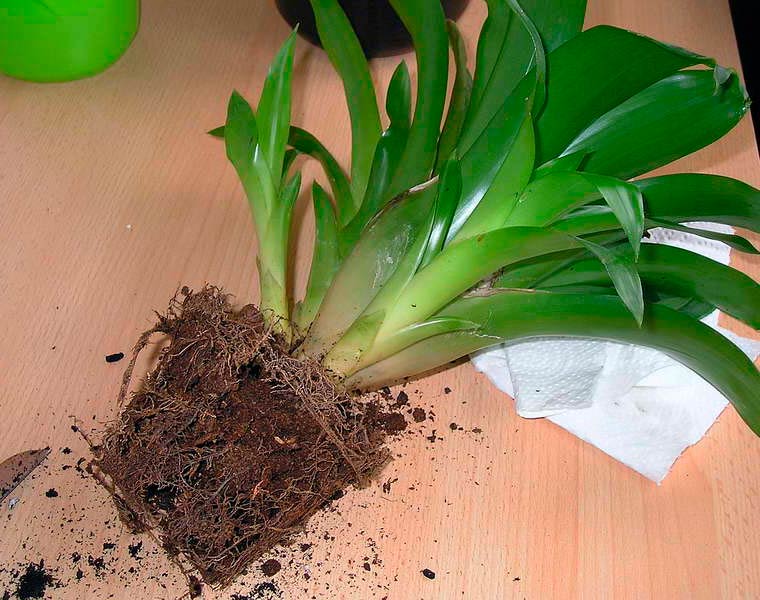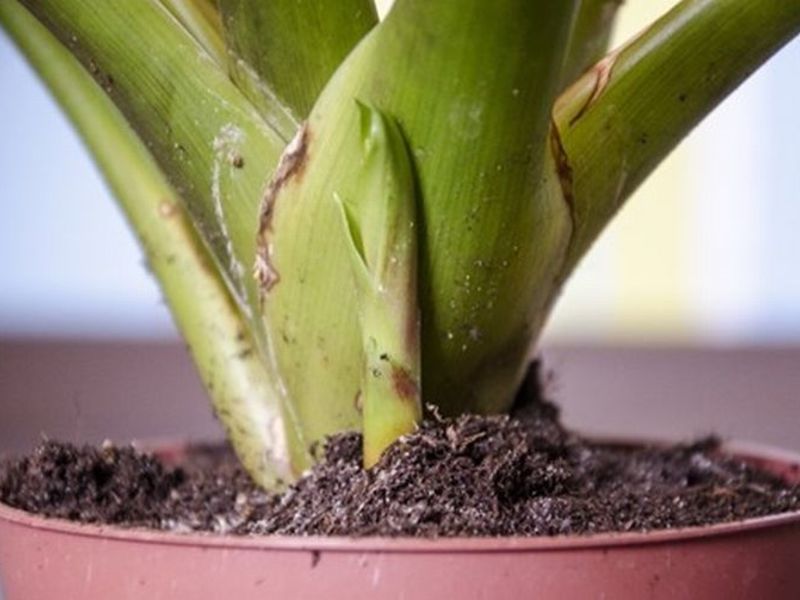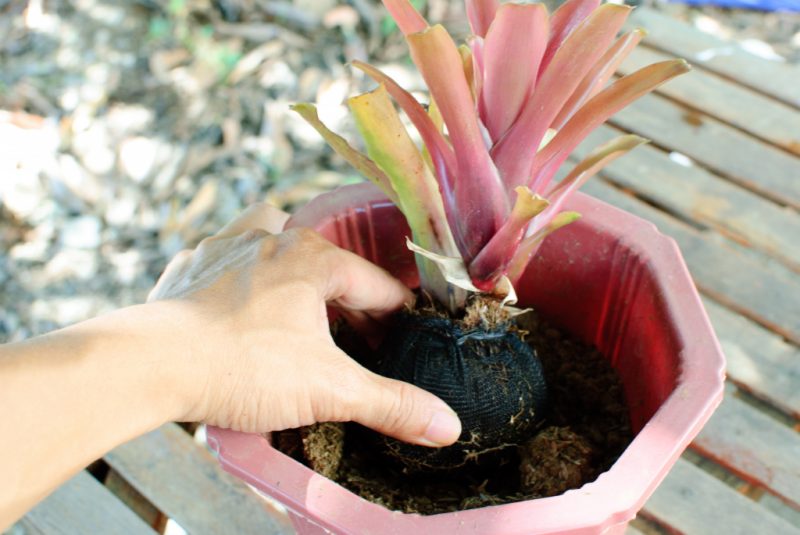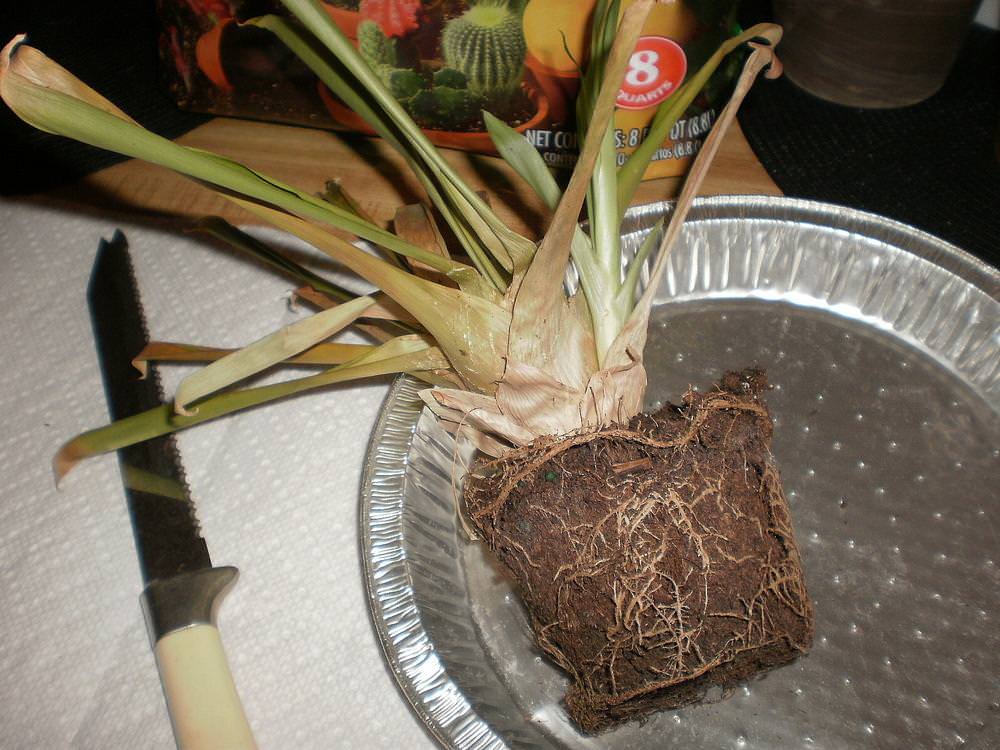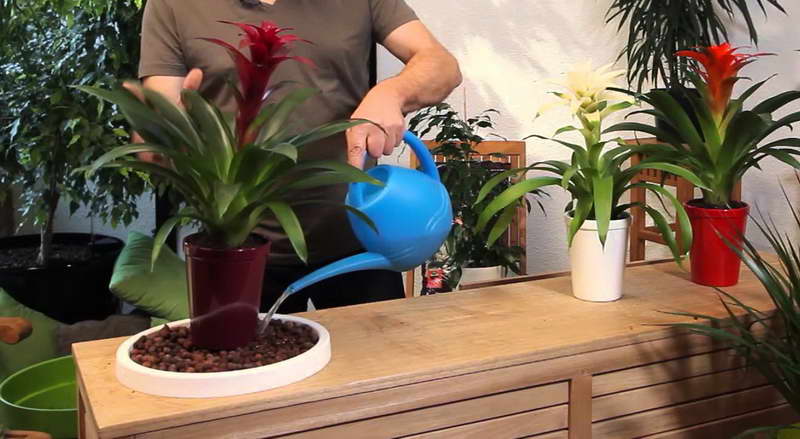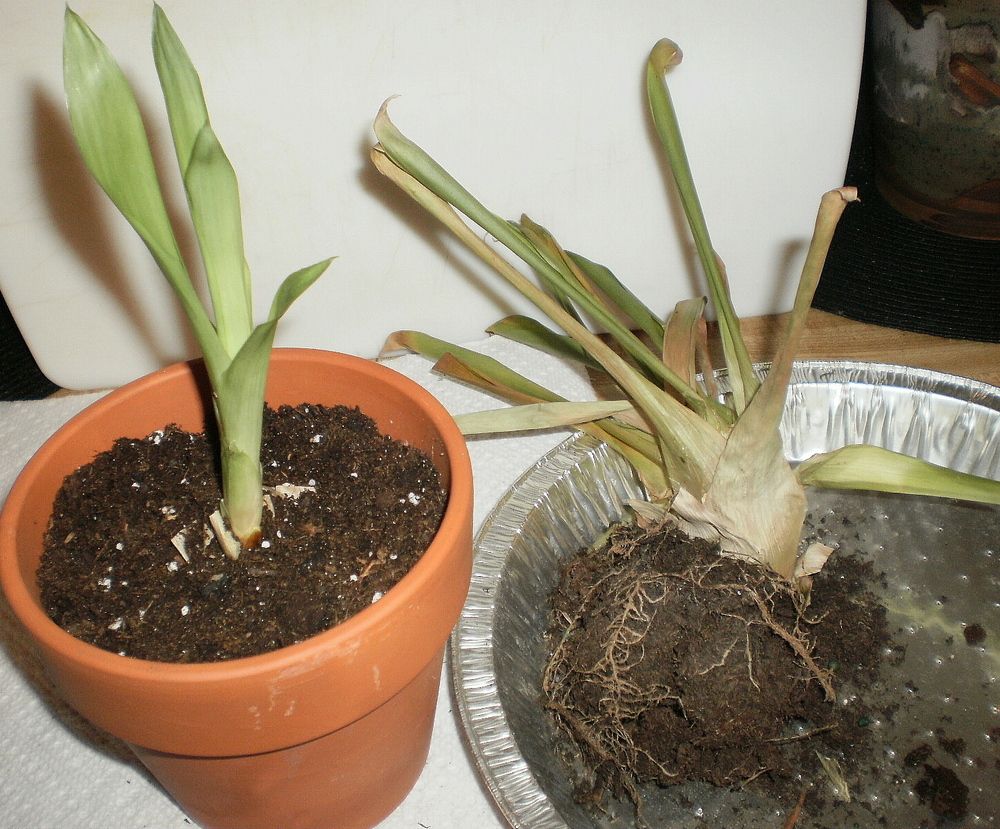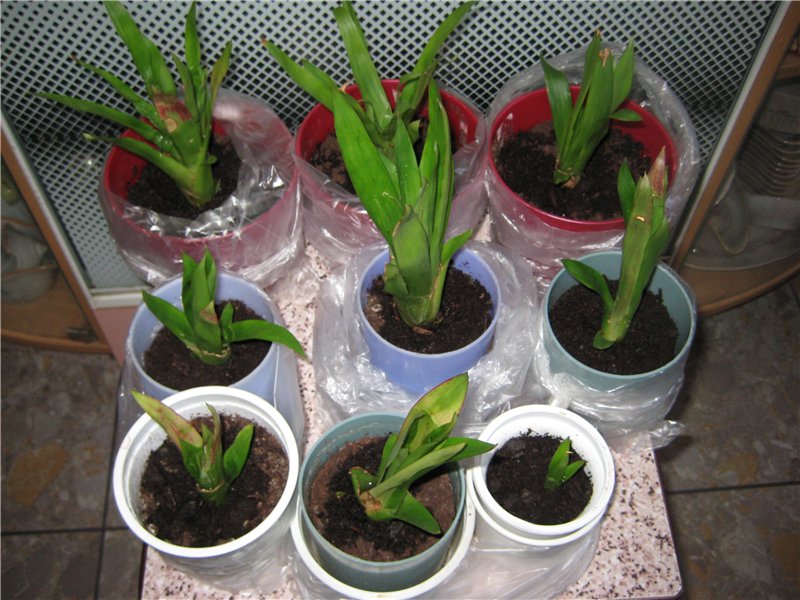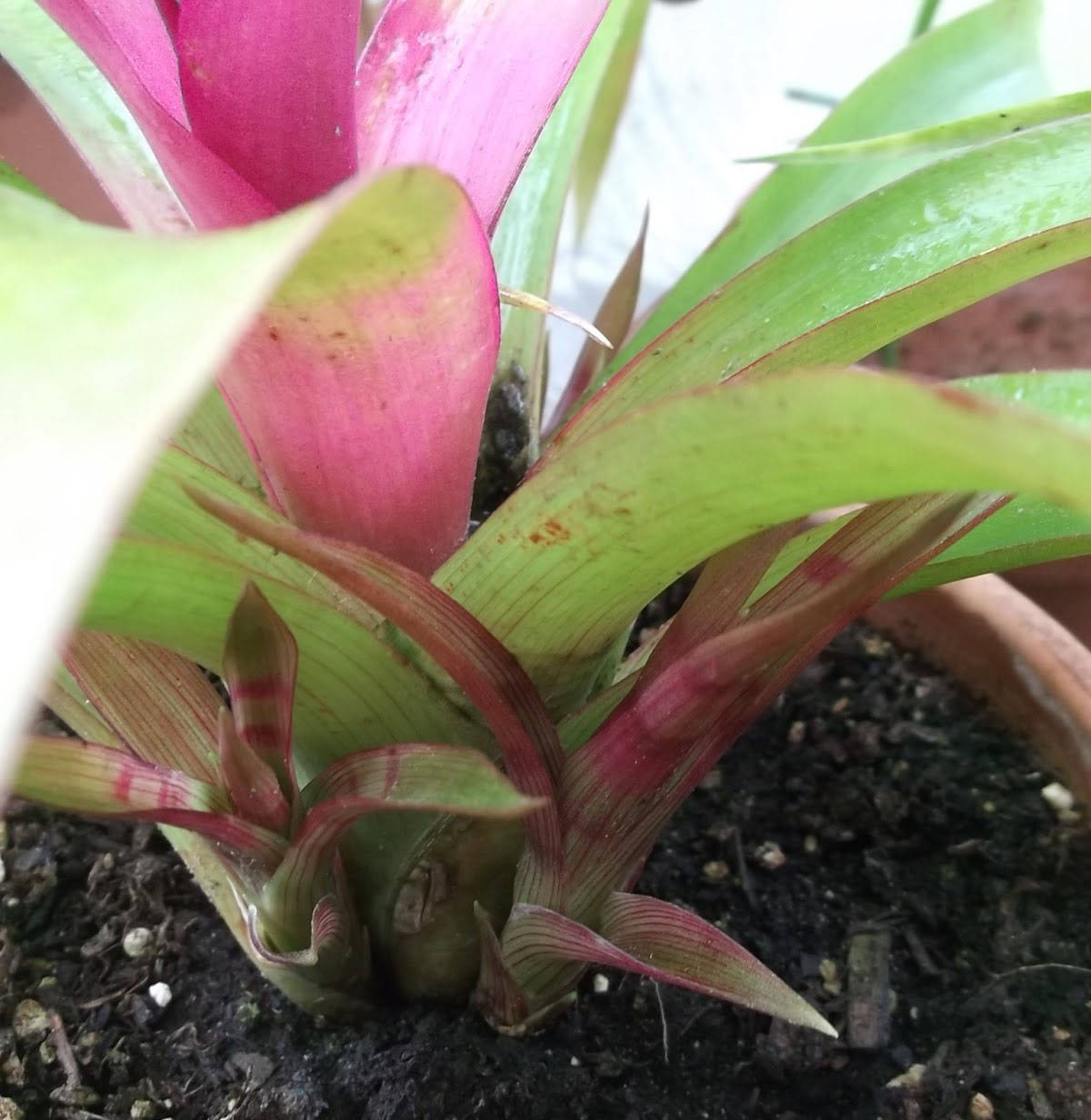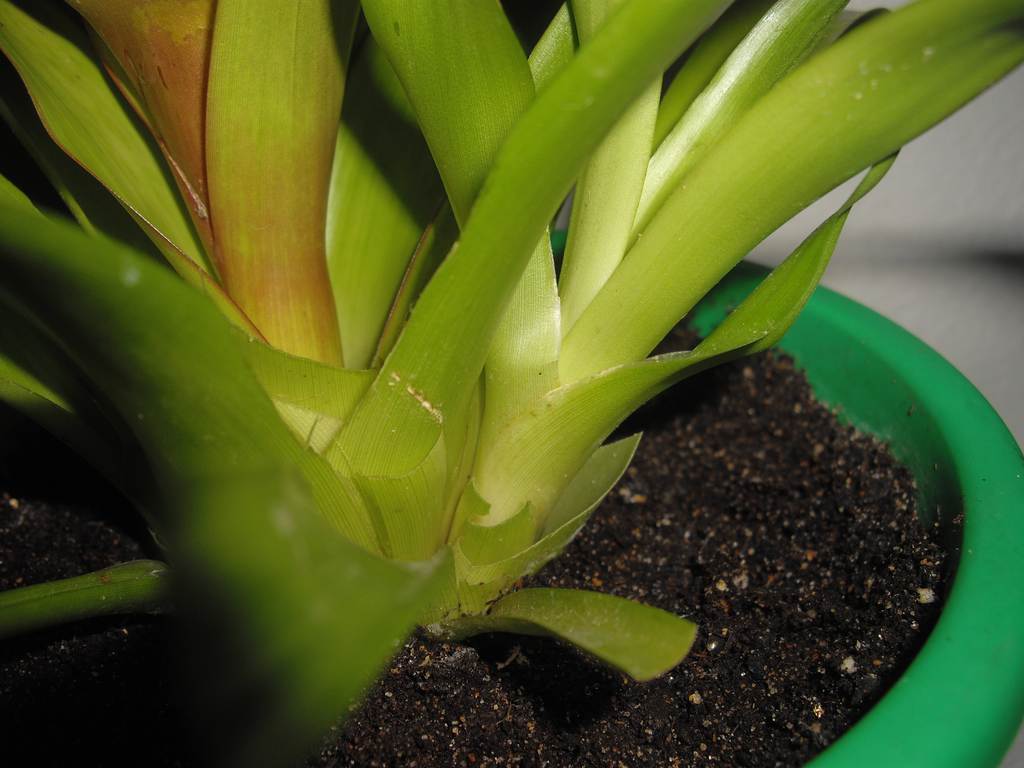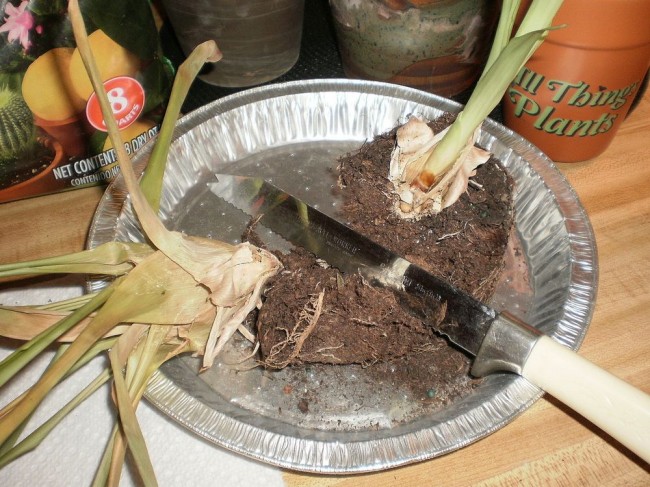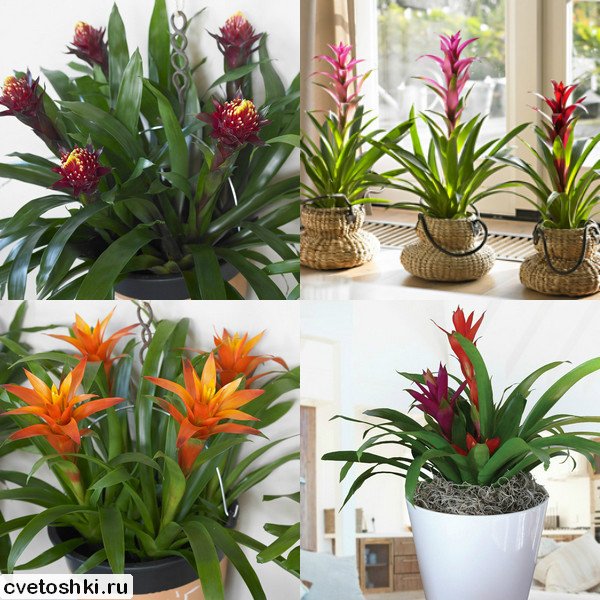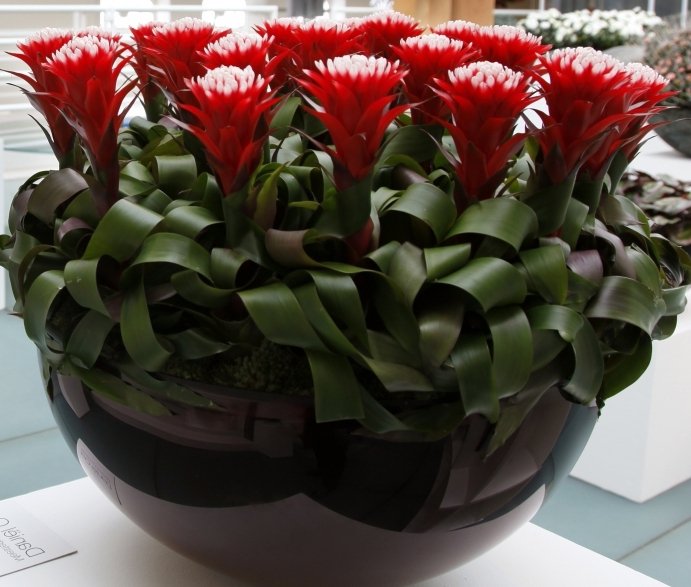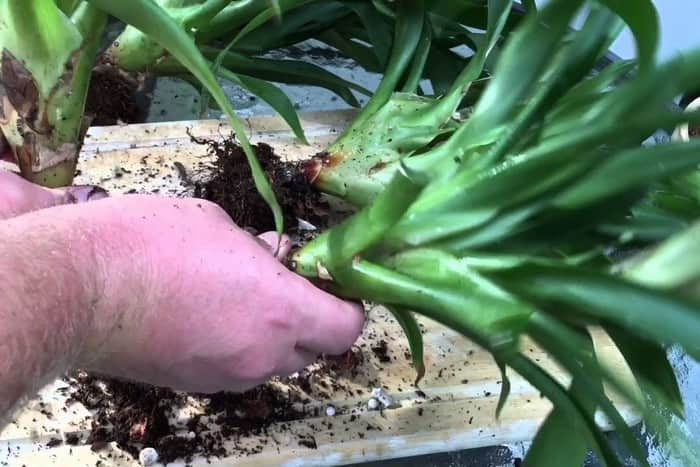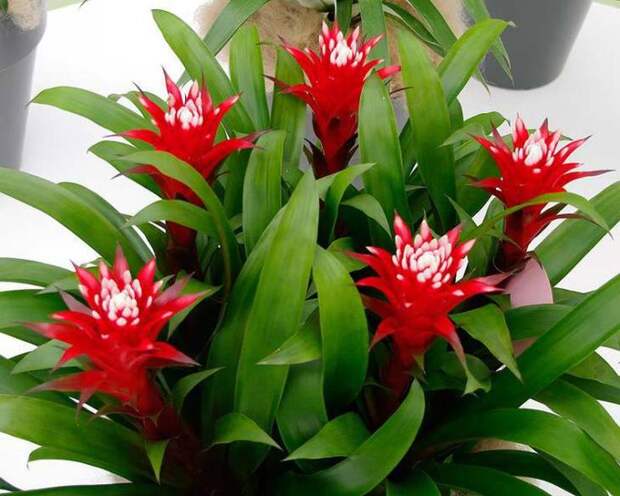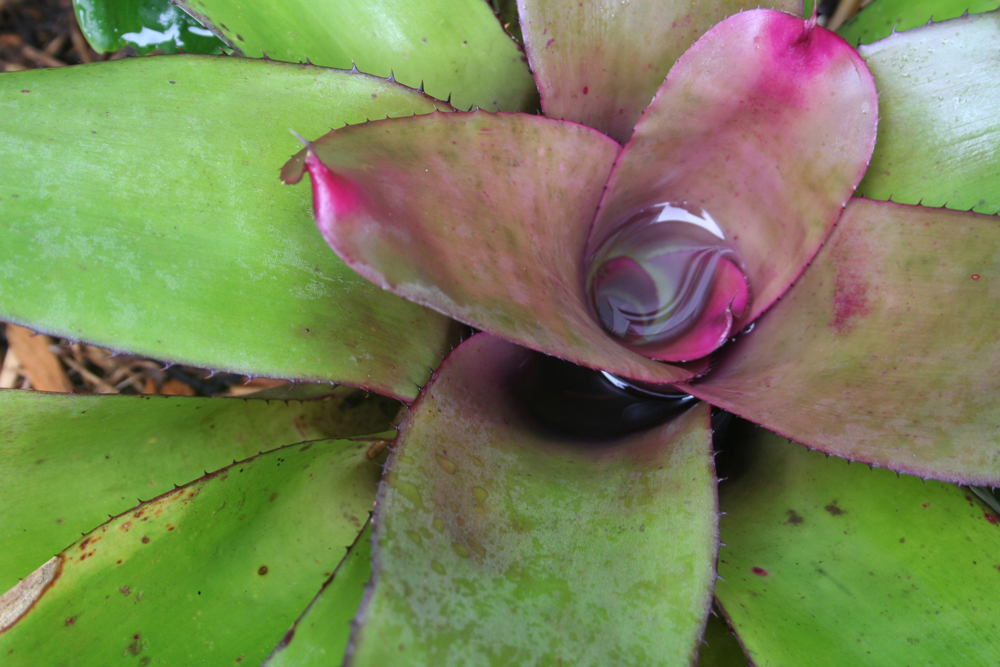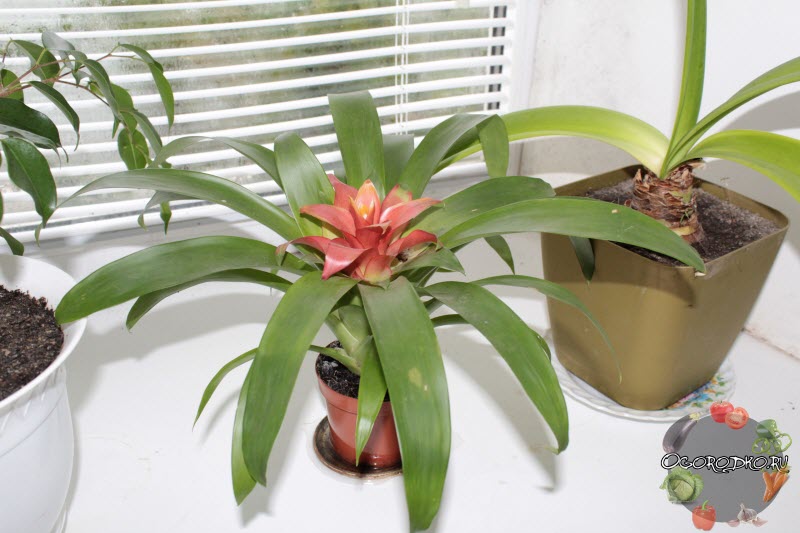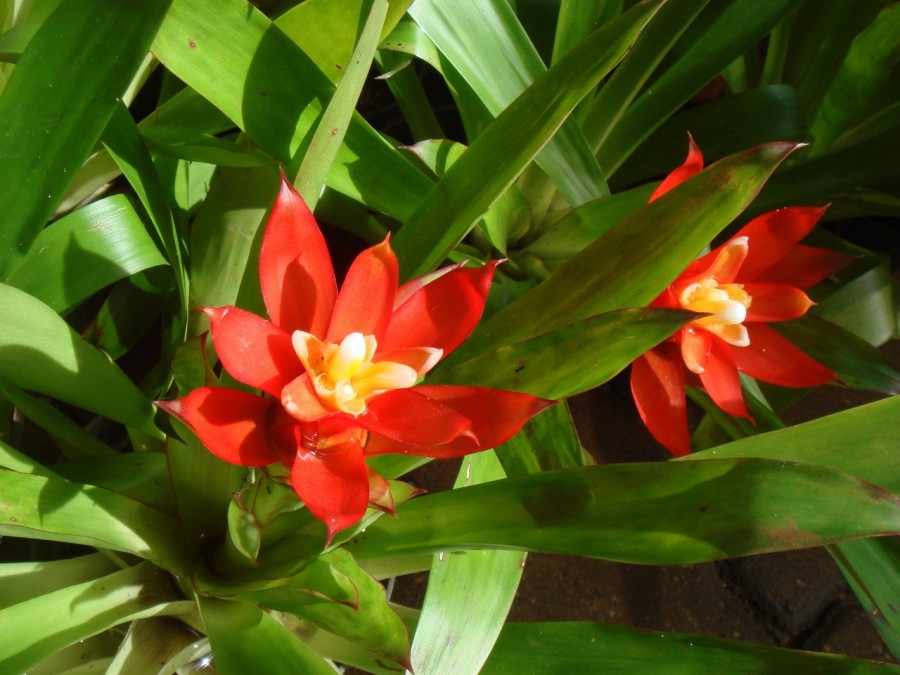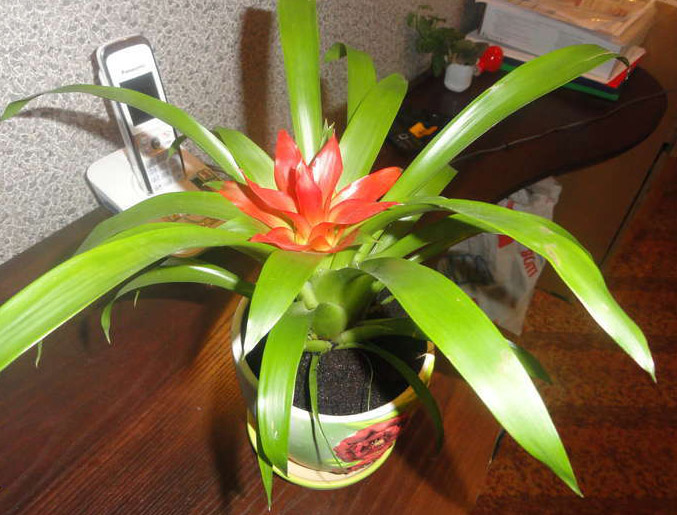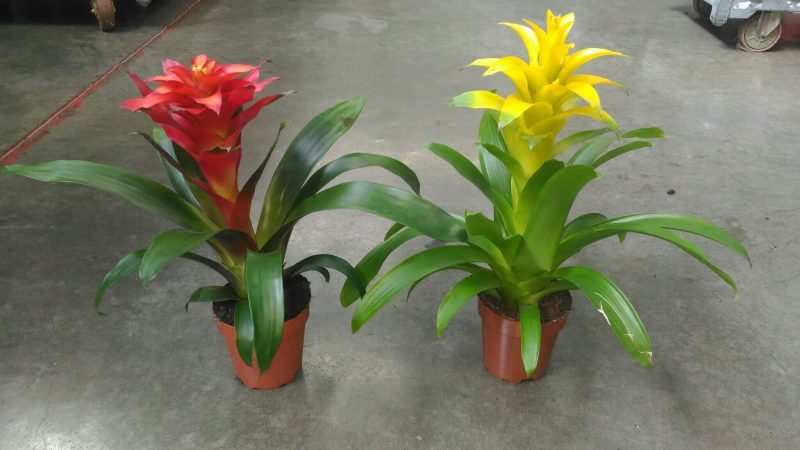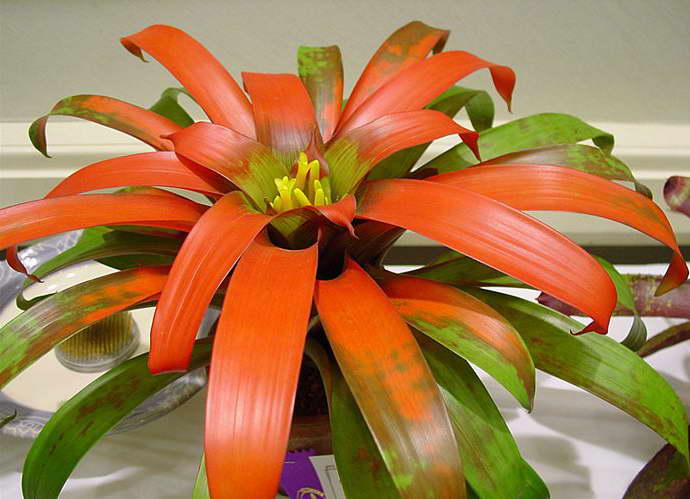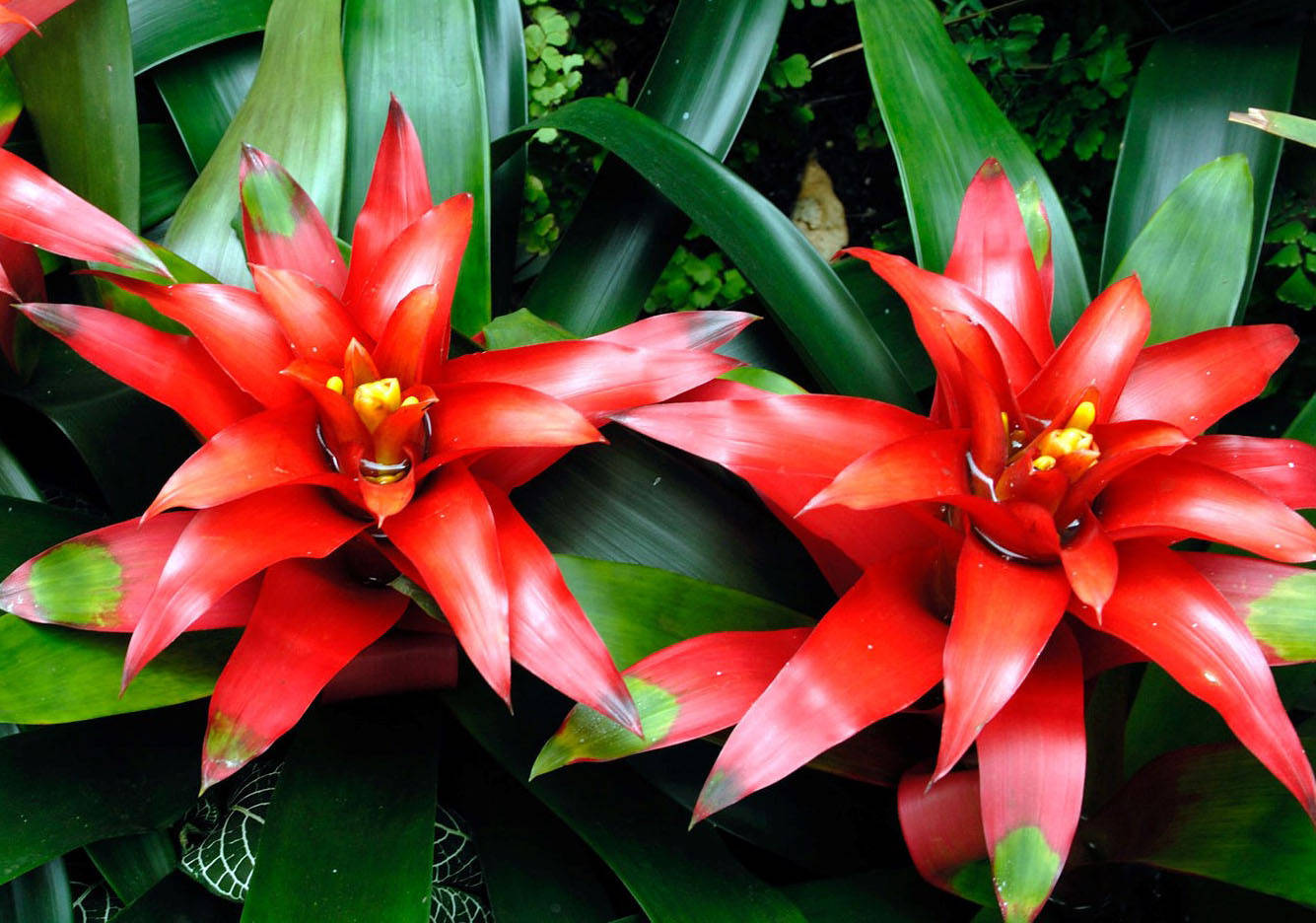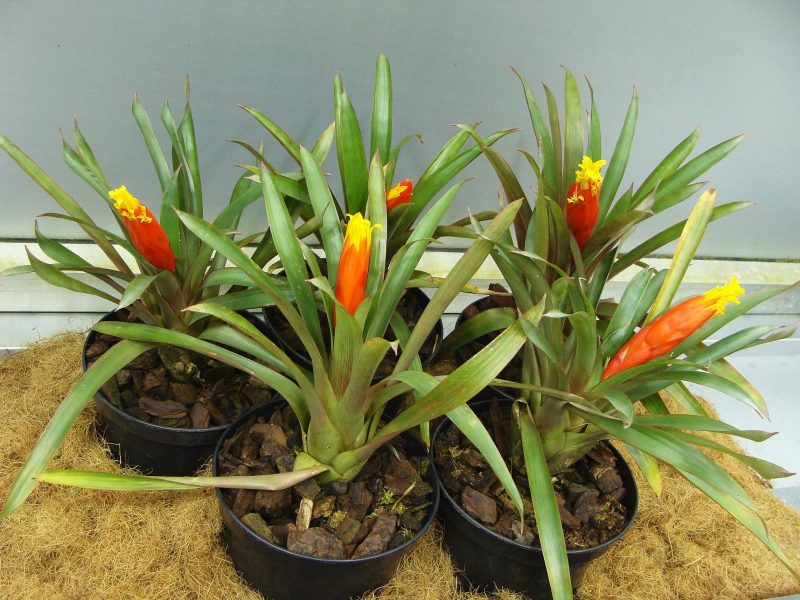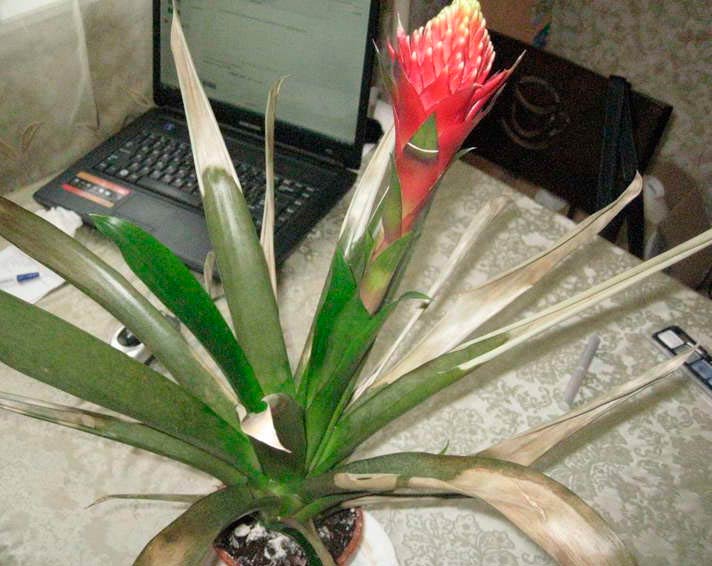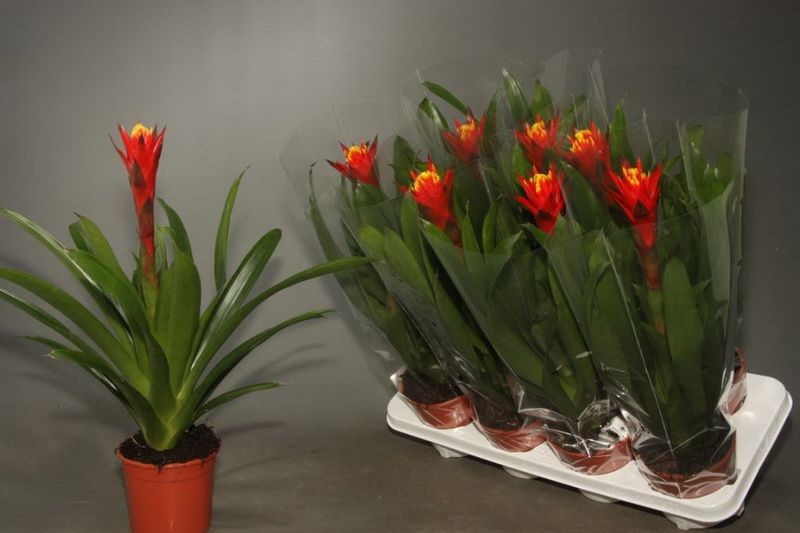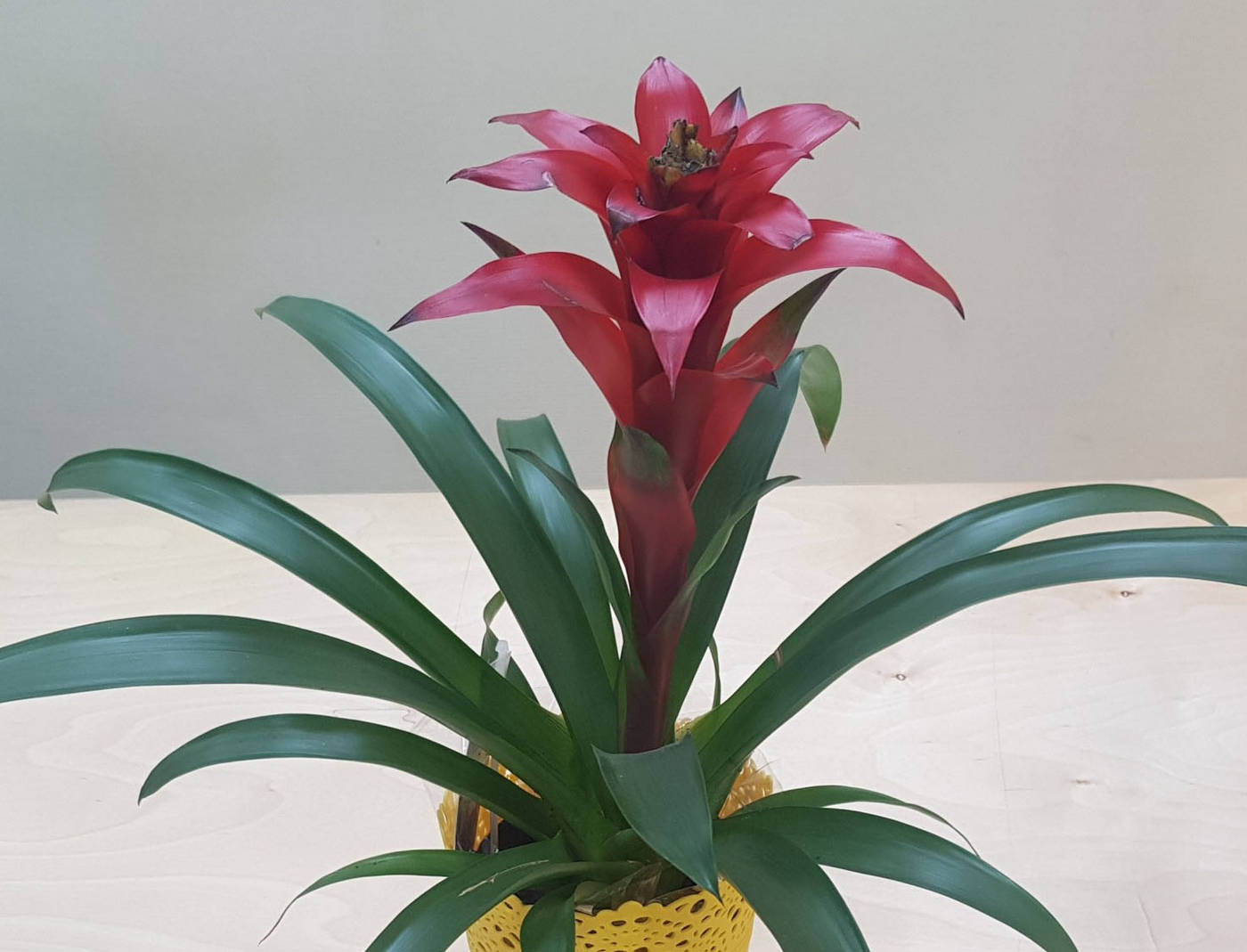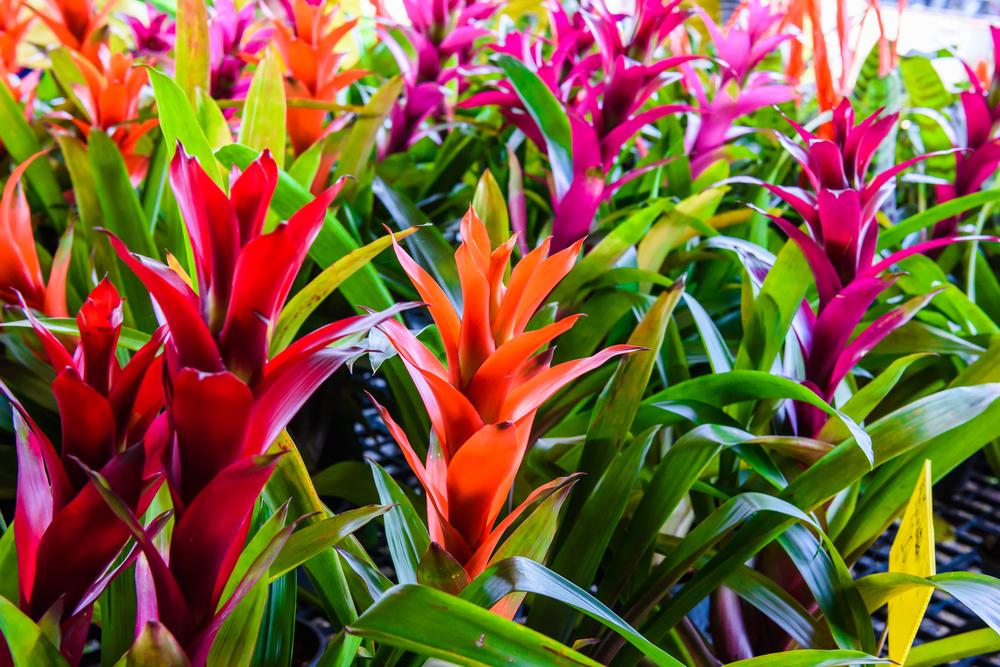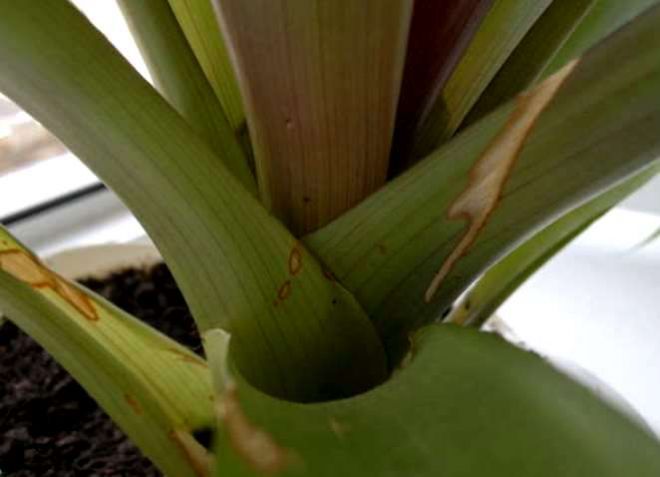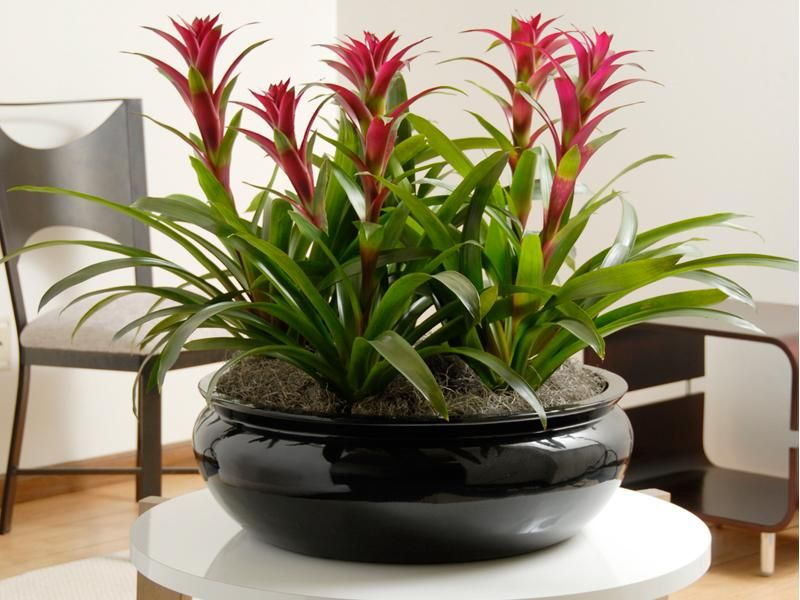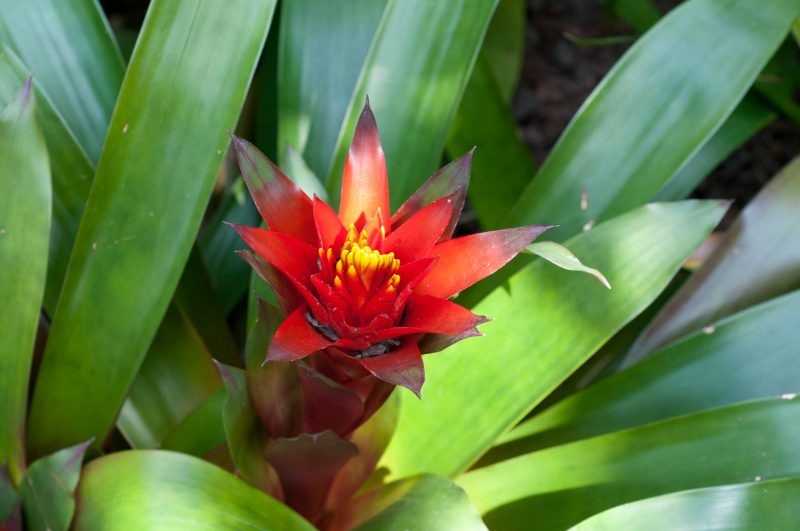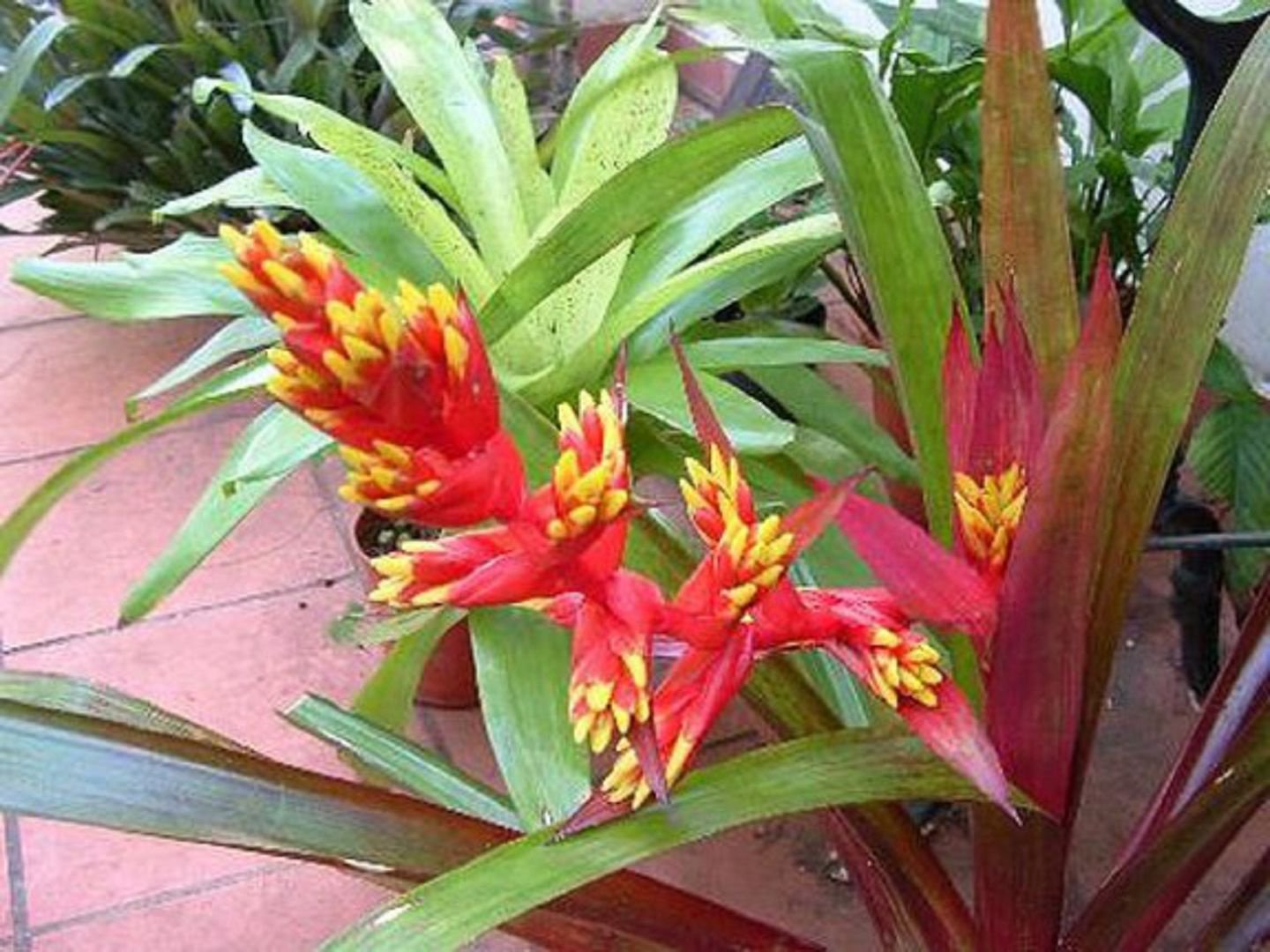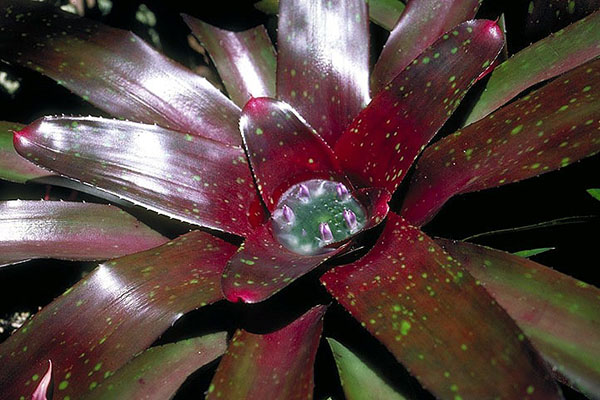How to properly care for guzmania at home
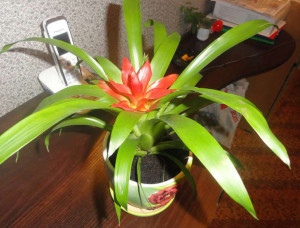
Lighting plays an important role for the plant.
Caring for any kind of guzmania at home is carried out according to one general rules for its content, thanks to which it is possible to create conditions for this exotic plant that are closest to natural.
Lighting and air temperature
When growing guzmania, lighting plays an important role. The best option would be to place it on the windowsill of the western or eastern window. Because direct sunlight on the south side will negatively affect the general condition of the plant, and a lack of light on the north side can lead to a lack of flowering. The optimum air temperature should be at least twenty-five degrees in the summer and about eighteen in the winter. Humidity should be at least eighty-five percent. Guzmania requires regular ventilation of the room, but without drafts that slow down the onset of flowering and provoke the occurrence of certain diseases.
Watering
For watering guzmania, warm, settled water is used. It is poured into an outlet and remains there during the warmer months. In winter, the remaining water must be drained off some time after watering. In summer, you need to water the plant every day, in winter - twice a week. Gravel (moss) must be placed in the pallet, which must be periodically moistened. In especially hot weather, you can water the soil. It is necessary to spray guzmania daily.
Top dressing
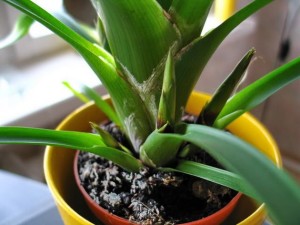
Plant feeding is not trumpeted
Guzmania does not require feeding. But to accelerate the appearance of the peduncle and increase the duration of flowering, you can feed it monthly during the summer with fertilizers for orchids, the solution of which is poured into the outlet.
Guzmania bloom
The flowering of guzmania is the most beautiful moment in the development of a plant, but at the same time it is the final one. As a rule, it occurs in the third year of growth, lasts for several months, after which the death of the flower as a whole occurs. Flowering occurs in spring or summer.
Guzmania care after flowering
When the guzmania fades, the peduncle needs to be cut off, the same should be done with gradually drying foliage. Daughter shoots will appear shortly thereafter, which are used to grow new plants.
Diseases, pests and ways to control them
If the conditions of detention are not observed, guzmania can be damaged by a number of diseases:
- Fungal diseases (powdery mildew, gray rot, and others), which are provoked by too high humidity and air temperature. The plant is treated with a fungicide;
- Guzmania can be infested with spider mites, scale insects and mealybugs. They appear at low air temperatures, waterlogged soil, contaminated soil. If pests are found, the plant must be treated with an insecticide.
Transplant and reproduction
Unlike traditional houseplants, replanting Bromilium regularly is not required. Replacing the substrate and pot is needed after purchase or when crushing and decaying the soil.
Transplant Algorithm
When replacing the transport soil, the transshipment method is used:
- Prepare a shallow but wide pot. Pour drainage material at the bottom.
- Prepare the substrate yourself or use a store-bought potting soil mixture designed for bromeliads.
- Gently pull out the guzmania without shaking off the old soil from the roots.
- Place in a new container, cover with fresh substrate, tamp lightly.
- Water the plant.
To fix the roots in a fresh substrate, fix the flower on a temporary support. Due to the severity of the outlet, it can tilt on its side and fall out of the pot.
Soil mixtures
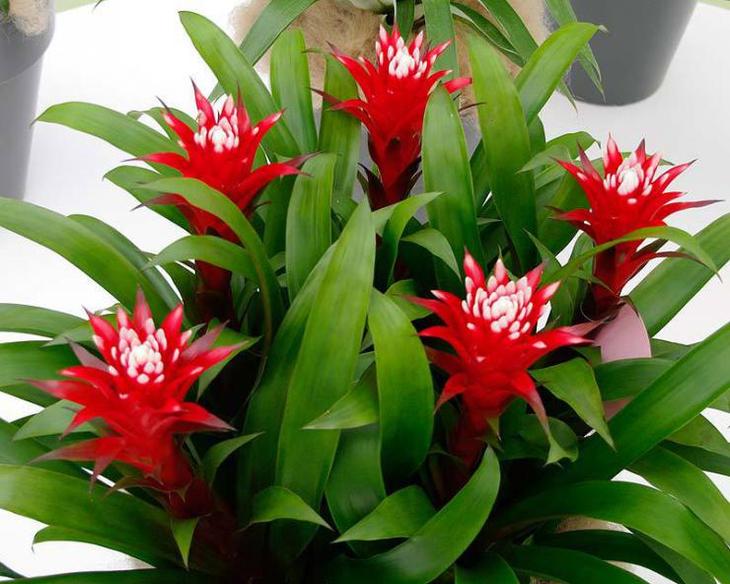
For transplanting and propagating room guzmania, you can use mixtures:
- ground rhizomes of fern, sphagnum 3: 1
- moss, sand, leafy soil, coniferous bark 1: 1: 2: 2
- coarse sand, humus, turf soil, peat 1: 2: 2: 4
Indicators of acidity of substrates - from 5.5 to 7.0
Reproduction
For guzmania, nature has provided two ways to reproduce offspring: by vegetative shoots - children and seeds. The first option is most preferable, since young plants will bloom in 2-3 years, and when planting seeds - only after 5 years.
When the leaves of the bracts begin to dry out, the flower is placed in a shaded place to accelerate the growth of children. The shoots that have grown to 1 / 3-1 / 2 of the height of the mother bush are separated with a sterile knife and planted in the substrate described above. To speed up rooting, cover the kids with a plastic cap.
For the second variant of reproduction, the peduncle is not cut off, but the seeds are allowed to ripen. For sowing, a soil mixture is prepared from peat and coarse sand. Seeds are sown on the surface without deepening, the soil is moistened, and glass is poured from above.
The container is placed closer to light and heat (22-25º C). Seedlings appear in 15-20 days. When they grow up and get stronger, they dive into the standard soil for guzmania.
Conclusion
At first glance, it seems that caring for guzmania is difficult and time consuming. But this will only be the case with your first flower, until you get the necessary experience.
In fact, it is important to observe only three main points:
- Humidity.
- Warmly.
- Light.
And also, competently raise children so as not to disrupt the cyclical life of the plant and enjoy flowering every year.
A source
The root system of Guzmania develops very slowly, and the plant can live in a pot for years. Transplanting is needed only in two cases - when you bought a plant in a transport pot and when it propagates. In the first case, the transplanting process is a little easier:
We prepare a wide, shallow (up to 15 cm) pot, pour drainage stones on the bottom;
We prepare a soil mixture from peat, sod land, sphagnum and coarse sand
Specialty mixtures for bromeliads are also sold in stores;
Carefully take out the plant, trying not to damage the roots, place it in a pot, fill it with the prepared mixture, slightly compact it from above;
We water both the soil and the plant itself .. If you transplant a "baby", that is, a new plant that has grown from an old bush, then after removing it from the old pot, you need to carefully separate their root systems
The mother plant dies after flowering and the formation of offspring, so that it remains only to throw it out
If you are replanting "baby", that is, a new plant that has grown from an old bush, then after removing it from the old pot, you need to carefully separate their root systems. The mother plant dies after flowering and the formation of offspring, so that it remains only to throw it out
Video for caring for guzmania at home
- this is a real island of exoticism in your apartment, which will help not only decorate the interior, but also activate your energy. It is easy to maintain as long as you put it in a comfortable place and water it regularly. This plant is suitable for both true gardeners and lazy houseplant lovers.
Bloom
Guzmania blooms only once in the second or third year of life. The spike-shaped inflorescence of inconspicuous white flowers is surrounded by bright bracts. They give the plant a spectacular appearance. Their color can be red, yellow, orange or pink.
Flowering duration is 3-5 months.To prolong it, do not allow water to enter the flowers and perianths. After flowering, the rosette gradually dies off.
Temperature regime
The plant is thermophilic. In summer, the optimum temperature for her is 20-25 degrees, but not higher than 28; in winter - 18-20 degrees. Lowering the thermometer below 15 degrees is undesirable: the flower may get sick and will not bloom.
Spraying
Home guzmania loves high environmental humidity, ideally 60-85%. The plant needs daily spraying with distilled or filtered water. During the flowering period, drops should not fall on flowers and bracts.
Lighting
The flower prefers diffused partial shade. It is optimal to place the pot of guzmania on the western or eastern windowsill. Do not allow direct sunlight to fall on the leaves, especially at noon: this can cause burns on the leaves, and the bracts will turn pale.
In winter, the flower can be rearranged to the south window so that the lack of light does not affect future flowering.
In summer, watering is plentiful, carried out as the soil dries up; in winter - temperate, the land should dry well between humidifications. The plant does not tolerate stagnant moisture.
Once a week, water is poured directly into the leaf outlet and left there until completely absorbed. At temperatures below 18 degrees, water is poured out of the outlet.
Pot
Since the plant has an underdeveloped root system, a shallow pot with a diameter of 10-12 cm is suitable for it. It is better that it be made of ceramics. In this case, the heavier and more voluminous above-ground part will not turn the container over.
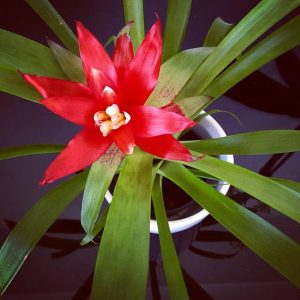 Guzmania minor. Photo
Guzmania minor. Photo
A plant at home needs a loose, light soil. A store-bought substrate for bromeliads or saintpaulias will do. To prepare the mixture yourself, you should combine:
- Leafy soil, high moor peat, sand and sphagnum in equal parts.
- Leaf soil and coconut fiber in one part, pieces of pine bark, sand and sphagnum - ½ part each.
- Universal soil, pieces of pine bark and sand in equal proportions.
1/3 of the pot should be occupied by a drainage layer (it should be laid on the bottom).
Guzmania transplant
After the purchase, it is necessary to transplant the guzmania from the transport substrate into the main nutrient soil. It is optimal to carry out the procedure by the transshipment method, carefully shaking off the roots from the old earth
In this case, it is important not to deepen the neck of the plant.
Since the guzmania dies after flowering, it does not need further transplants. The “baby” separated and planted in a new land continues its existence.
Breeding methods
There are several ways to propagate this houseplant. Guzmania can be propagated by lateral processes and seeds.
Division into processes
At the end of flowering, epiphytes have children, which are lateral processes. The mother socket itself will die off over time, and will no longer grow and bloom. But children can be separated from it, from which a new beautiful bush will eventually grow.
For plant propagation, the shoots should be separated only after their roots have reached at least one and a half centimeters in length. With the help of a sharp knife, the children are separated from a large bush, after which the cut on all plants is processed with garden varnish.
The separated outlets are planted in containers filled with soil for orchids, and are covered for the first time with a polyethylene cap. Caring for them consists in keeping them warm, daily ventilated and in watering, which is carried out only after the top layer of the soil has dried.
Sowing seeds
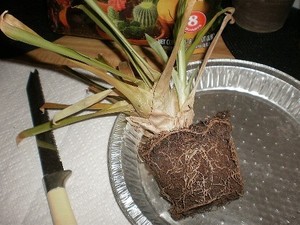 Before sowing, the seeds must be washed in a solution of potassium permanganate and dried. After that, they are sown on the surface of the soil, which consists of sand and crushed peat. Guzmania seeds need light for germination, so the containers are covered with plastic or glass and placed in a warm, bright place.At home, at an air temperature of +24 degrees, seedlings should appear in 2-3 weeks. During this time, the soil should be ventilated daily and, when dry, sprayed with warm water from a spray bottle.
Before sowing, the seeds must be washed in a solution of potassium permanganate and dried. After that, they are sown on the surface of the soil, which consists of sand and crushed peat. Guzmania seeds need light for germination, so the containers are covered with plastic or glass and placed in a warm, bright place.At home, at an air temperature of +24 degrees, seedlings should appear in 2-3 weeks. During this time, the soil should be ventilated daily and, when dry, sprayed with warm water from a spray bottle.
About two months after the seedlings sprout, they are dived into a container with a soil mixture, which should consist of the following components:
- peat - 4 parts;
- sod land - 1 part;
- leaf land - 1 part.
Grown up matured plants are transplanted into permanent pots by transferring. They should be looked after in the same way as for adult plants.
The bushes are transplanted into permanent pots after another six months. They do not grow very quickly, and they will bloom not earlier than after 3-5 years.
Diseases and pests
Guzmania is an unpretentious plant, and yet it happens that it can get sick. This happens when the rules for keeping the flower are violated, improper watering, the use of cold water to feed the root system. To prepare in advance and know about the possible ailments of the plant, you should familiarize yourself with the tips of experienced flower growers.
If gray spots appeared on the spreading and green leaves, then the plant was struck by gray rot. The disease is fungal but treatable. As a treatment, you must use a mixture of fungicide. Processing is done several times.
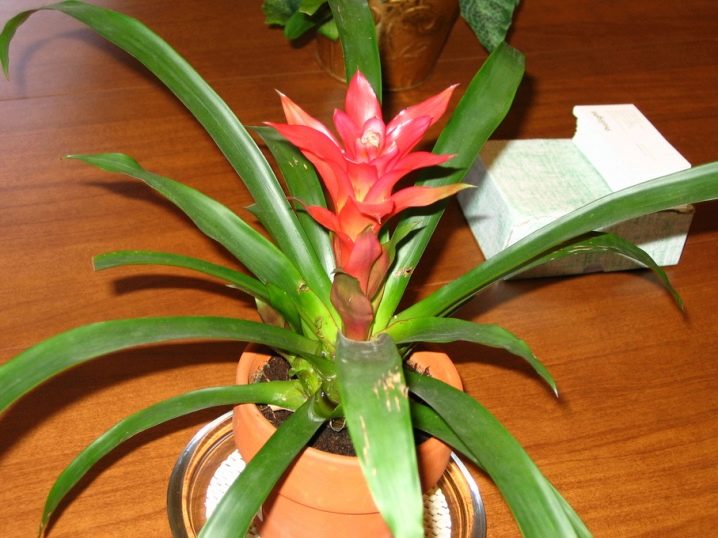







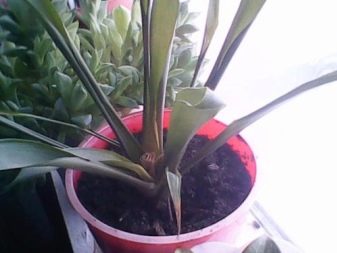

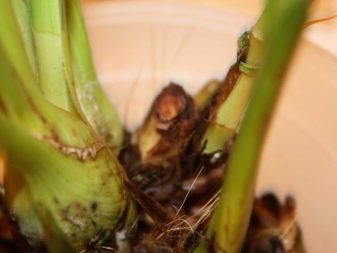



From the presented list of possible diseases, it becomes clear that with timely watering, quality care and decent lighting, the guzmania will not be able to pick up any ailment.
Their appearance is not difficult to determine. The leaves become spoiled, plaque appears on them, a thin cobweb. In cases of the appearance of harmful microorganisms, the leaves must be blotted with a cotton pad previously moistened with a solution of laundry soap. The plant itself will have to be sprayed with an insecticide, for example, "Aktar". "Aktellik" and "Fitoverm" have identical properties with it. You should not come up with ways to dilute drugs on your own. The instructions provided by the manufacturer detail the preparation method for each mixture used.
For the secrets of caring for guzmania, see the video presented.
How to care at home
The care consists in standard procedures, but there are some important nuances.
Watering
Watering guzmania is one of the most important procedures. Water for epiphyte should be 3-4 degrees higher than the air temperature. Rainwater is ideal. Tap water must be filtered, since any substances from the mainline negatively affect the development of the plant.
You can use a home filter: activated carbon wrapped in several cotton swabs. The filter is pressed against the tap hole and water is passed through it with a thin stream.
Watering is carried out in several ways:
- irrigation of the soil coma - no more than 2 times a week. In winter, watering is reduced, watering the ground only after the soil dries up to half the volume;
- drip (inside the outlet) - during the period of growth and flowering, the outlet should be filled with water by 2-3 cm. Every week the water is changed. In winter, the socket must be dry;
- bottom watering - applied every 10 days. The container is immersed in water until the soil is completely moistened.
Water must always be present in the outlet, except in winter. Watering the soil - irrigation or bottom - is chosen at the discretion of the grower.
Fertilization
It is better to use a mineral complex (for example "Success").
Find out how and how to feed indoor plants at home.
The balanced composition nourishes the roots and green mass, enhances the resistance to diseases (most often chlorosis). The dosage is reduced by three times the norm indicated on the package.

Fertilized during the period of active development - from May to August - with an interval of 2 weeks.
Pruning
Pruning as such is not carried out, since after the flower dries up and the inflorescence wilts, the plant dies.But in order to prolong his life and admire the bright bracts longer, the wilted flower is removed from the top.
Transfer
The transplant is carried out every 2-3 years, in the spring. Wide and shallow pots are recommended. It is better to prepare the soil for the epiphyte yourself.
For the soil mixture, take the following components:
- pine bark (chopped) - 3 parts;
- chopped sphagnum - 1 part;
- peat - 1 part;
- humus - 0.5 parts.
Find out more about how to transplant guzmania at home.
Expanded clay is used as a drainage layer, filling it with a third of the volume of the pot.
The sequence of actions for a transplant will be as follows:
- The soil ball is moistened to make it easier to remove the bush along with the roots without damaging them.
- The plant is thrown out of the old container, the dried leaves are removed.
- A layer of soil is poured onto the drainage, the bush is carefully placed on the soil and covered on all sides of the pot.
- The root collar is not buried; it remains on the surface.
- The transplanted bush is removed in the shade for 3-4 days, moistening the soil lump daily.

Features of care for gusmania
Lighting for gusmania
Gusmania can be grown in a bright or shaded place. She prefers diffused light, from direct sunlight at noon it should be shaded, for example, with translucent paper or cloth. Grows well on west or east windows. Grows well on northern windows, but may not bloom. In the summer, gusmania can be taken out into the open air, but it should be protected from sunlight, rain and drafts. If you do not have the opportunity to place the plant outdoors in the summer, then you should regularly ventilate the room.
In the autumn-winter period of gusmania, good lighting is needed; during this period, shading is not required. Additional lighting can be created using fluorescent lamps, placing them above the plant at a distance of 50-60 cm, for at least 8 hours a day. In the autumn-winter period, it is also necessary to ventilate the room, but drafts should be avoided.
Gusmania watering and air humidity
During the growing season (from March to October), gusmania is watered abundantly, as the soil dries up. Water is poured into the outlet funnels, preferably in the morning. The water must be changed periodically in the funnels. Before the onset of the dormant period after the flowering of the gusmania, the water is drained from the outlet. In winter, watering is moderate, with a content below + 20 ° C, water is not poured into the funnels, but the plant is sprayed.
Plants placed on a bromeliad tree are removed from the support at least 1 time in 10 days and immersed in settled water until saturated, after which excess water is allowed to drain and returned to its place.
Water for watering gusmania is used well-settled and soft, 2-3 degrees above room temperature.
If the plant is kept above + 20 ° C in winter, you can occasionally pour a small amount of water into the outlet, only in the morning and always warm.
Like all bromeliads, gusmania prefers high humidity. Growing in a terrarium or a humid greenhouse is optimal for her. It is necessary to spray the plant several times a day. To increase moisture, the plant can be placed on a pallet with damp moss, expanded clay or pebbles. In this case, the bottom of the pot should not touch the water. You should periodically wipe the leaves of gusmania with a damp cloth, cleaning them from dust, the use of a special wax to make the leaves shine is not desirable.
From May to August, gusmania fertilizers are carried out once a month, while the fertilizer is diluted with water for irrigation and poured into an outlet. Fertilizer is used special for bromeliads or for ordinary indoor plants, but taken in a dose four times less than for other plants. It must be remembered that the dose of nitrogen in the fertilizer should be low, its excess can cause the death of the plant.
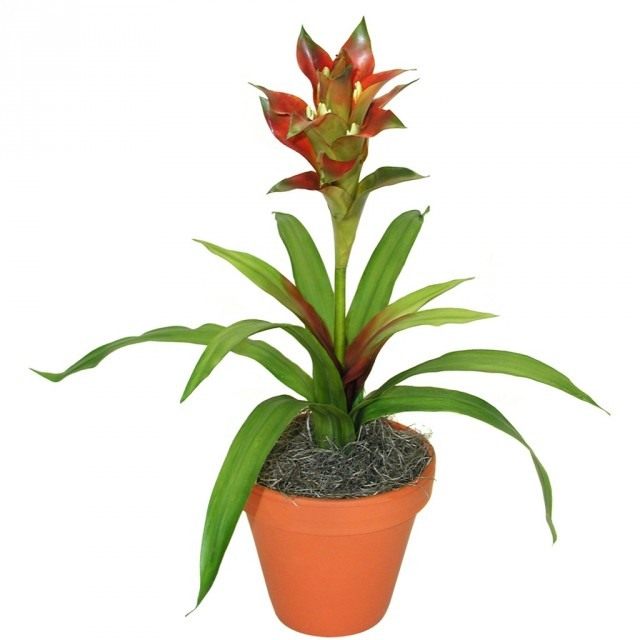 Gusmania, cultivar "Scarlet Star"
Gusmania, cultivar "Scarlet Star"
Gusmania transplant and substrate
Gusmanias are transplanted as needed, 1 time every 2-3 years. During transplantation, the neck of the plant is not buried; this can cause the plant to rot and die.
The substrate for growing gusmania should be porous, drainage should be at least 1/3 of the height of the pot. For epiphytic species, the mixture is made up of crushed pine bark, chopped sphagnum, high peat, leafy, humus soil (or dry mullein) in a ratio of 3: 1: 1: 1: 0.5 with the addition of perlite and pieces of charcoal.
For terrestrial species of gusmania, a substrate is prepared from leafy, humus earth, peat and sand (2: 1: 1: 0.5). Sphagnum, sod land, bark of coniferous trees, and charcoal are used as additives. The planting container should not be too deep, it is better to use wide bowls.
Popular species in floriculture
- Guzmania today has more than a hundred different species. However, only a few varieties are grown at home.
- Tempo. This species attracts with its contrast: against the background of delicate, light green leaves, a bright red bract stands out favorably. Leaves are elongated, shiny, dense rosette. Height about 35 cm.
- Ostara. It's a hybrid. It has narrow, bright green leaves. The stem is long, it has scarlet bracts, white flowers appear a little later, fade quickly. Unpretentious care. Widespread among florists.
- Reed. Perhaps the most popular species among Guzmania. The rosette is dense, the leaves are wide, the perianth is bright, from scarlet to yellow. The flowers are small, cream-colored, collected in inflorescences, spikelets, do not bloom for long. Reed guzmania has varieties: purple, fiery, small, modest, ordinary.
- Minor - Rondo. A beautiful small plant, green leaves, erect bracts, red, small, white flowers, in large numbers, collected in inflorescences. Flowering begins in February.
- Calypso. This is one of the finest types of gusmania. The rosette is loose, collected from narrow leaves of light green color, the bract is erect, its leaves are directed upwards, have a bright red color.
- Blood red. A distinctive feature of this species is that the very middle of the outlet is bright red. The central funnel is often almost completely filled with moisture. Therefore, the flowers of the plant literally float in it.
- Mosaic. The peduncle itself is short, the bract consists of small leaves, painted in red or orange. The decorative value of this species lies in the leaves - they have a striped color.
- One-headed. Absolutely unremarkable, small bract. This type of gusmania has decorative long leaves painted in longitudinal stripes.
Guzmania: how to care at home
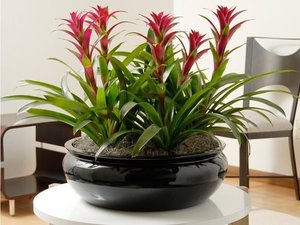
The best place for guzmania
The comfortable temperature for this perennial ranges from 18-25 ° C. In summer, the thermometer should not exceed 26 ° C. In winter, the temperature is at least 18 ° C. When the flowering period begins, it is best to keep the home temperature between 24-25 ° C.
The substrate can consist of leafy soil, humus, moss, peat and sand. A drainage cover must be present at the bottom.
Home care for guzmania primarily consists of water. From spring to late autumn, watering is carried out as the soil dries up. The flower is watered directly into the leaf rosette. Water must be taken at room temperature and separated. In the summer, a liquid should always be present in the core, which is replaced with a clean one once a month. If the room temperature is below 20 ° C, then the outlet is not watered at all, but a small amount of water is poured into the soil. The leaves also need to be looked after, from time to time wipe with a wet sponge.
Moisture plays a big role in the plant. That is why guzmania needs spraying every day.There is another way to maintain humidity: a pot of gusmania is placed in a container with water and expanded clay.
The plant is fed in the summer once a month. Fertilizers are used for bromeliads or flowering houseplants. The drug is diluted in water and gradually poured into the rosette of leaves. The feeding dose should be 4 times less than for other flowers.
Gusmania blooms only once in a lifetime, blooming lasts for eight months, and six months later the plant dies, leaving children.
Guzmania bloom
What, what, and the flowering period is the most difficult aspect in caring for guzmania. As a rule, flowers form only after 3-5 years of plant life. It lasts for several months, and this is the culmination of the life of a beautiful plant.
But flowers can appear only if the guzmania is comfortable in the surrounding conditions. If the long-awaited moment does not come, then the matter may be:
- Lack of light or, conversely, aggressive exposure to direct sunlight;
- Lack of fertilizers and nutrients; Dry air.
There is a little trick to speed up the process of flower emergence. To do this, place apple slices on the soil next to the plant and cover it with a bag. The released ethylene will be released into the air and the plant will bloom.
Make sure that the apples and the bag do not start to grow moldy, otherwise you will infect the plant.
Main problems
In the process of growing room guzmania, novice flower growers may encounter some difficulties.
It is important to know about them in advance in order to take effective measures.
Containment breach
The wrong composition of the soil leads to a violation of the growth and flowering of indoor guzmania. You can solve this problem by choosing the optimal soil for the plant. It must have a light airy structure. Additionally, the following components should be added in equal parts:
- peat;
- coarse sand;
- leafy ground;
- sod land;
- sphagnum moss.
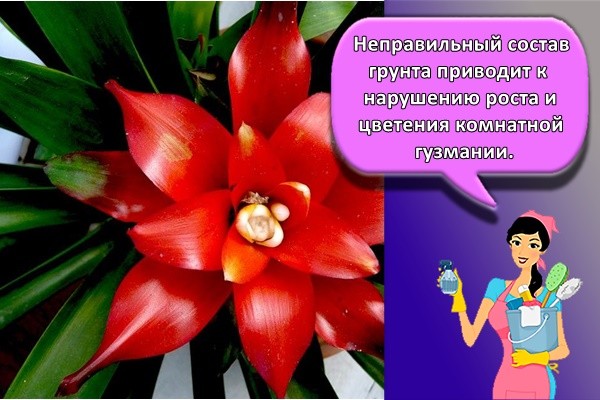
Wrong location
Too dark places in the apartment, as well as places in direct sunlight, have a bad effect on the well-being of the guzmania. She may dry out the tips of the leaves and stop flowering.
Improper nutrition
The food of the indoor guzmania mainly occurs through the leaves. Do not apply fertilizer directly to the soil, as this causes burns to the root system.
Excess moisture
An excessive amount of water in the soil leads to rapid decay of the roots and base of the stem. To avoid this, you need to provide effective drainage in the pot. It is also necessary to drain the water from the outlet in time that the plant did not drink, if it has not evaporated.
Lack of water in the outlet
The lack of water in the outlet of the plant, combined with too dry air, leads to drying out of the leaves and roots. Therefore, you need to carefully monitor the general condition of the guzmania, and in case of evaporation of water in the funnel, add about a third of it.
Sunburn
Burns by direct rays of the sun provoke overdrying and curling of the tips of the leaves, as well as covering the entire leaf surface with unattractive brown spots.
Spraying with hard cold water
Guzmania, being a typical tropical inhabitant, does not tolerate cold hard water, especially if it contains particles of calcium and chlorine. Water for spraying the leaves must be defended for a day, and then passed through a filter.
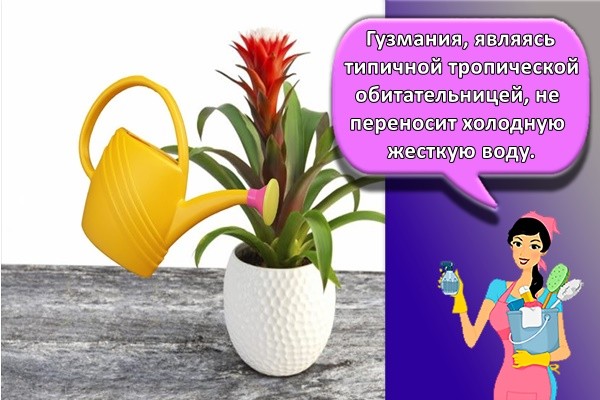
The peduncle was not cut
Sometimes the owners of the guzmania do not cut the peduncle in time, waiting for the formation of the seeds of the plant. In this case, the process of formation of new fresh shoots is significantly slowed down.


